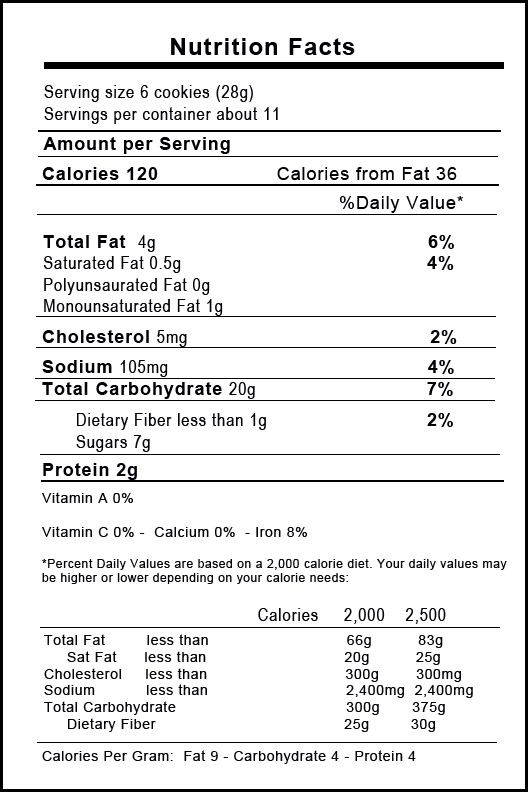Learn how to read a food label... plus you can print out a sample label to make a small poster below.
The new food labels mandated by the Food and Drug Administration for processed foods were non most products as of July, 1994. Single ingredient foods, such as fresh fruits, vegetables, meat, poultry, fish and unprocessed grains are not required to have labels. The new labels must contain the following information.
Click Here To Download Food Label Poster (Pdf.)
The first listing on a food label is what is considered a serving size for the product. For example, the label may read “serving size 6 cookies”. This means numbers and percentages listed are for the serving size listed. Next the label will tell you how many servings are in the package. In the cookie example, if the label reads “servings per container 12”, that means there are 6 x 12= 72 cookies in the container. If you eat them all, that’s 12 servings not one that you have eaten.
Many people get confused by this number because they are not reading these two items carefully.
The next section gives you a list of amount per serving. First you will see the total calorie count and calorie amount that come from fat. (Remember this is per serving). For example, if it reads “120 calories and calories from fat 36” this means that each serving is 120 calories which 36 of those calories comes from fat.
The next section gives you a breakdown of how much fat each serving contains. The fat amount is measured in grams. The label also shows you the percent daily value according to a 2000 calorie diet. You will notice that total, saturated, polyunsaturated and monounsaturated fat.
You will next see cholesterol and sodium measured in milligrams (mg) and the daily percent value. The top two sections should be avoided or limited as much as possible.
Total carbohydrate, dietary fiber and sugars are shown in grams (g). Also the daily percent value is also listed. For example, your product may contain 20 grams of carbohydrate which may account for 7 percent of your total carbs your body need for the day. The amount of Protein is also listed in grams but it does not list the percentages.
The next section list minerals that are important and you should try to get enough of in your diet. These are vitamin A, C, Calcium and Iron which list the percentage each serving give your body.
The next section below gives you the suggested amount of each of the above sections in grams and milligrams for a 2000 and 2500 calorie diet. For example a label will give you the following readings.
Total fat less than 66g for 2000 83 g for 2500
Sat fat less than 20 g for 2000 25 g for 2500
Cholesterol less than 300g for 2000 300 mg for 2500
Sodium less than 2,400 mg for 2000 and 2,400 mg for 2500
Total Carbohydrate 300 g for 2000 375 g and 2500
Dietary Fiber 25g for 2000 and 30 g for 2500
The last thing you will see is a calories per gram listing for fat, carbohydrate and protein. For example, it will show fat 9, carbohydrate 4 and protein 4.
Label Reading
The new food labels mandated by the Food and Drug Administration for processed foods were non most products as of July, 1994. Single ingredient foods, such as fresh fruits, vegetables, meat, poultry, fish and unprocessed grains are not required to have labels. The new labels must contain the following information.
Total calories
Cholesterol
Sugars
Calcium
Calories from fat
Dietary fiber
Protein
Iron
Total fat
Sodium
Vitamin A
Saturated fat
Total Carbohydrates
Vitamin C
When reading labels:
1. Look carefully at the serving size. If your normal serving size is more or less than the serving listed, you’ll need to adjust when considering the amount of fat(or carbohydrates, or proteins) in the product.
2. Look at the calories from fat. Figure the percent of calories coming from fat by dividing the total calories into the calories from fat . Figure the percent of calores coming from fat by dividing the total calories into the calories from fat (in the example above: 36/120 = 30%
3.Look at the grams of fat in the food and consider how this food fits into your total daily fat gram allotment.
4.The percentage (%) daily value can be confusing for some clients. It measures the amount of the particular nutrient in the food (e.g.,fat) against the amount of that nutrient an average person is supposed to have in one day. So, if you consume a 2,000 calorie per day diet, 30% fat is 600 calories from fat or about 65-66 grams of fat (see bottom of label). A serving of six cookies nets four grams of fat which is 6% of the 66 total grams of fat you are allowed per day.
5.On the bottom of each label is a little nutrition lesson.
To learn more about reading food labels... check out Food Labels: Understanding What You're Eating. This quick manual will easily break down everything you need to know so you can start eating healthier.



